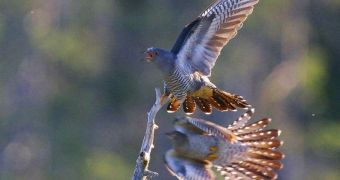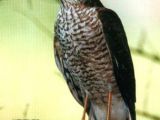Two thousands years ago, Plutarch said that the cuckoo was transforming into a hawk. You just have to look at a cuckoo and a sparrowhawk side by side, and you will positively be smitten by the resemblance between the two in terms of plumage, size and posture. Of course, cuckoos have nothing to do with raptors, but they mimic the sparrowhawk in the color of their pale, barred bellies, and breasts.
Cuckoos seem to have developed this disguise to scare away the other smaller birds in whose nests they lay their eggs. The birds fly away, leaving their nest exposed, and the cuckoo female rapidly lays an egg in it, while removing one from the host.
When turning back to their nests, the birds act around the cuckoo's egg as if it were one of their own; the newly hatched cuckoo chick will finish the job its parents had started, by tossing out of the nest the other eggs/chicks. For long, reed warblers have evolved side by side with cuckoos and are no longer fooled by its pattern.
In a study recently published in the Proceedings of the Royal Society B, the team made of behavioral ecologists Nick Davies and Justin Welbergen, of the University of Cambridge (U.K.), found that warblers aggressively attacked stuffed cuckoo models located near their nests,, while flying away as quick as possible when seeing stuffed hawks. The team placed taxidermy models, from harmless controls (collared doves and teals) to sparrowhawks and cuckoos, near peanut feeders, to see the reaction of other species too.
Blue and great tits, normally not nest parasitized by the cuckoo, were indifferent to the controls but flew away at the sight of the the hawks and cuckoos models, releasing alarm calls even after the removal of the stuffed models.
When the team covered the cuckoos' barred ventral part with a white strip, the tits continued to feed, indifferent to the presence of the model. By covering the cuckoos in hand-barred silks (this way, the signal was emphasized), the tits became again agitated. "They treated barred cuckoos like hawks and unbarred [camouflaged] ones like doves," said Welbergen.
This research is "the first evidence for a 2000-year-old belief that has never been rigorously tested," adds behavioral ecologist Oliver Kruger of the University of Cambridge. With all that, the researchers continue to remain puzzled by one thing: how come the warblers have learned to tell the difference between cuckoos and hawks?

 14 DAY TRIAL //
14 DAY TRIAL // 
